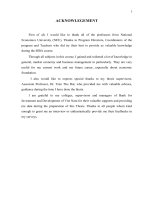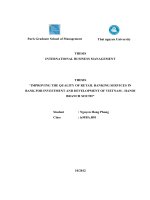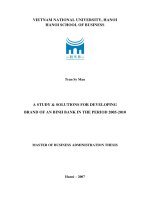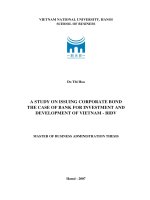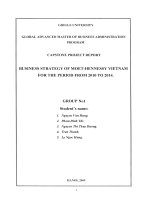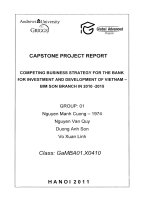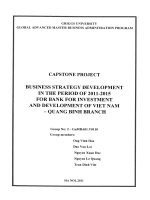Development strategy of bank of investment and development of vietnam in the period of 2010 2015
Bạn đang xem bản rút gọn của tài liệu. Xem và tải ngay bản đầy đủ của tài liệu tại đây (2.65 MB, 143 trang )
DEVELOPMENT STRATEGY OF BANK OF INVESTMENT AND
DEVELOPMENT OF VIETNAM IN THE PERIOD OF 2010-2015
INTRODUCTORY
1. Rational of the study
Business strategy is the foundation of successful business. But there are, of course,
different types of business strategy. The best business strategies must steer a course
between the inevitable internal pressure for business continuity and the demands of
a rapidly changing world for revolutionary business strategies.
A full statement of a selected business strategy is a business plan defining:
•
the company vision
•
the strategy and tactics that will enable the company to reach those objectives
•
the resources required, and how they are going to be obtained;
•
what the main milestones and steps are along the way;
•
who is responsible for causing each step to occur;
•
what are the company's business risks and external factors that need to be kept
under review for indications that a change in strategy or plan may be required.
Strategizing is much more than just visioning, forecasting and planning. In the new
rapidly changing economy, all substantive issues of strategy have been redefined as
issues of implementation. Today, strategizing is concerned with the match between
the internal capabilities of the company and its external environment. "The modern
subject of business strategy is a set of analytic techniques for understanding better,
and so influencing, a company's position in its actual and potential marketplace".
There is great potentional for consumer banking including SMEs and individaul
given the low banking penetration rate and country’s weng and growing population.
With the opening of local banking market under WTO the competition will become
much fiecer. WTO accession brings about both opportunities and challenges for
1
Vietnam in general and financial banking industry in particular. As a leading state
owned commercial bank in Vietnam, BIDV should have right awareness of
international integration process, proactively construct its own action plans, map the
strategic targets in the time to come, the bank need great effort to reform in all
fields. All this suggests the critical need to plan for competition in the years ahead
and the critical need to have competitive advantage to not only maintain the market
share but to develop. BIDV’s success may depend on developing a realistic plan to
achieve competitive advantage in several critical products or services, then growing
from a base of strength.
BIDV is among the biggest state commercial banks of Vietnam, with big capital scale,
functioning as universal commercial banks, providing full range of currency, credit,
banking and non-banking services. Main targets of BIDV are to become the leading
financial group in Vietnam with 4 main activities: Commercial banking, securities,
insurance, and investment,” now BIDV completed equitization and have just
conducted IPO bid in first quarter of 2009. We include 4 students, of whom 3 students
are BIDV’s employees. We chose the research topic of “Development strategy of
bank of investment and development of Vietnam in the period of 2010-2015”, wishing
to apply theory in evaluating business situation of our bank and base on that, we hope
to build up a good strategy for next 5 years with solutions and tactics to successful
realize the strategy. We do hope that, after completing this project, we will be more
mature and successful thanks to knowledge and skill learnt from Griggs’s MBA.
2. Study objective
With topic “Development strategy of bank of investment and development of
Vietnam in the period of 2010-2015”, objectives of this research study are
formulated as followed:
1. Systematize theoretical issues no strategy, especially strategy for banking
activities
2. Analysis and evaluation on the strategy of BIDV in previous time
2
3. Recommendations on strategic solutions aiming at developing banking
activities in the future.
3. Subject, scope and methods of research
Subject of research: Strategic activities of BIDV, especially banking activities. In
details, strategic analysis, strategic formulation and choice.
Scope of research: The topic is researched in the scope of BIDV’s banking
activities. Relating activities such as Securities, insurance… are not in the scope of
research.
Research method: Documentary and reality research (Survey...); Probabilities
methods, analysis and synthesis methods.
4. Structure of the research
Introductory
Chapter I: Theoretical foundation of business strategy, application in banking sector
Chapter II: Current situation of BIDV’s strategy
Chapter III: Orientation for development strategy of BIDV in 2010-2015 periods
Conclusion
3
CHAPTER I
THEORETICAL FOUNDATION OF BUSINESS STRATEGY
AND APPLICATION IN BANKING SECTOR
This theoretical framework will serve as a foundation for analysis in chapter 2 and
chapter 3, including: 1) Overview of strategy and strategic management; 2) Strategy
formulation; 3) Strategy implementation; 4) Features of banking industry
1.1 Overview of strategy and strategic management
1.1.1 Strategy
What is strategy? There is no single, universally accepted definition. Various
authors and managers use the term differently.
Strategy According to Henry Mintzberg
Henry Mintzberg, in his 1994 book, The Rise and Fall of Strategic Planning, points
out that people use "strategy" in several different ways, the most common being
these four:
1. Strategy is a plan, a "how," a means of getting from here to there.
2. Strategy is a pattern in actions over time; for example, a company that regularly
markets very expensive products is using a "high end" strategy.
3. Strategy is position; that is, it reflects decisions to offer particular products or
services in particular markets.
4. Strategy is perspective, that is, vision and direction.
Mintzberg argues that strategy emerges over time as intentions collide with and
accommodate a changing reality. Thus, one might start with a perspective and
4
conclude that it calls for a certain position, which is to be achieved by way of a
carefully crafted plan, with the eventual outcome and strategy reflected in a pattern
evident in decisions and actions over time. This pattern in decisions and actions
defines what Mintzberg called "realized" or emergent strategy.
Mintzberg’s typology has support in the earlier writings of others concerned with
strategy in the business world, most notably, Kenneth Andrews, a Harvard Business
School professor and for many years editor of the Harvard Business Review.
Strategy According to Kenneth Andrews
Kenneth Andrews presents this lengthy definition of strategy in his book, The
Concept of Corporate Strategy:
"Corporate strategy is the pattern [italics added] of decisions in a company that
determines and reveals its objectives, purposes, or goals, produces the principal
policies and plans for achieving those goals, and defines the range of business the
company is to pursue, the kind of economic and human organization it is or intends
to be, and the nature of the economic and non-economic contribution it intends to
make to its shareholders, employees, customers, and communities.
Andrew’s definition obviously anticipates Mintzberg’s attention to pattern, plan,
and perspective. Andrews also draws a distinction between "corporate strategy,"
which determines the businesses in which a company will compete, and "business
strategy," which defines the basis of competition for a given business. Thus, he also
anticipated "position" as a form of strategy. Strategy as the basis for competition
brings us to another Harvard Business School professor, Michael Porter, the
undisputed guru of competitive strategy.
5
Strategy According to Michael Porter
In a 1996 Harvard Business Review article and in an earlier book, Porter argues that
competitive strategy is "about being different." He adds, "It means deliberately
choosing a different set of activities to deliver a unique mix of value." In short,
Porter argues that strategy is about competitive position, about differentiating
werself in the eyes of the customer, about adding value through a mix of activities
different from those used by competitors. In his earlier book, Porter defines
competitive strategy as "a combination of the ends (goals) for which the firm is
striving and the means (policies) by which it is seeking to get there." Thus, Porter
seems to embrace strategy as both plan and position.
Strategy According to Kepner-Tregoe
In Top Management Strategy, Benjamin Tregoe and John Zimmerman, of KepnerTregoe, Inc., define strategy as "the framework which guides those choices that
determine the nature and direction of an organization." Ultimately, this boils down
to selecting products (or services) to offer and the markets in which to offer them.
Tregoe and Zimmerman urge executives to base these decisions on a single "driving
force" of the business. Although there are nine possible driving forces, only one can
serve as the basis for strategy for a given business. The nine possibilities are listed
below:
1. Products offered
4. Production capability 7. Natural resources
2. Market needs
5. Method of sale
3. Technology
6. Method
8. Size/growth
of 9. Return/profit
distribution
6
It seems Tregoe and Zimmerman takes the position that strategy is essentially a
matter of perspective.
Strategy According to Michel Robert
Michel Robert takes a similar view of strategy in, Strategy Pure & Simple [8],
where he argues that the real issues are "strategic management" and "thinking
strategically." For Robert, this boils down to decisions pertaining to four factors:
1. Products and services
3. Market segments
2. Customers
4. Geographic areas
Like Tregoe and Zimmerman, Robert claims that decisions about which products
and services to offer, the customers to be served, the market segments in which to
operate, and the geographic areas of operations should be made on the basis of a
single "driving force." Again, like Tregoe and Zimmerman, Robert claims that
several possible driving forces exist but only one can be the basis for strategy. The
10 driving forces cited by Robert are:
1. Product-service
6. Sales-marketing method
2. User-customer
7. Distribution method
3. Market type
8. Natural resources
4. Production capacity-capability
9. Size/growth
5. Technology
10. Return/profit
7
Strategy According to Treacy and Wiersema
The notion of restricting the basis on which strategy might be formulated has been
carried one step farther by Michael Treacy and Fred Wiersema, authors of The
Discipline of Market Leaders. In the Harvard Business Review article that presaged
their book, Treacy and Wiersema assert that companies achieve leadership positions
by narrowing, not broadening their business focus. Treacy and Wiersema identify
three "value-disciplines" that can serve as the basis for strategy: operational
excellence, customer intimacy, and product leadership. As with driving forces, only
one of these value disciplines can serve as the basis for strategy. Treacy and
Wiersema’s three value disciplines are briefly defined below:
1. Operational Excellence
Strategy is predicated on the production and
delivery of products and services. The objective is
to lead the industry in terms of price and
convenience.
2. Customer Intimacy
Strategy is predicated on tailoring and shaping
products and services to fit an increasingly fine
definition of the customer. The objective is longterm customer loyalty and long-term customer
profitability.
3. Product Leadership
Strategy is predicated on producing a continuous
stream of state-of-the-art products and services. The
objective is the quick commercialization of new
ideas.
Each of the three value disciplines suggests different requirements. Operational
Excellence implies world-class marketing, manufacturing, and distribution
8
processes. Customer Intimacy suggests staying close to the customer and entails
long-term relationships. Product Leadership clearly hinges on market-focused R&D
as well as organizational nimbleness and agility.
1.1.2
Strategic management
The nature and value of strategic management
Managing activities internal to the firm is only part of the modern executive’s
responsibilities. The modern executive also must respond to the challenges posed
by the firm’s immediate and remote external environments. The immediate external
environment includes competitors, suppliers, increasingly scarce resources,
government agencies and their ever more numerous regulations, and customers
whose preferences often shift inexplicably. The remote external environment
comprises economic and social conditions, political priorities, and technological
developments, all of which must be anticipated, monitored assessed, and
incorporated into the executive’s decision marking.
However the executive often is compelled to subordinate the demands of the firm’s
internal activities and external environment to the multiple an often inconsistent
requirements of its stakeholders: owners, top managers, employees, communities,
customers and country. To deal effectively with everything that affects the growth
and profitability of a firm, executive employ management processes that they feel
will position it optimally in its competitive environment by maximizing the
anticipation of environmental changes and of unexpected internal and competitive
demands.
Strategic management is defined as the set of decisions and actions that result in the
formulation and implementation of plans designed to achieve a company’s
objectives. It comprises nine critical tasks:
9
1. Formulate the company’s mission, including broad statements about its purpose,
philosophy, and goals.
2. Conduct an analysis that reflects the company’s internal conditions and
capabilities
3. Assess the company’s external environment, including both the competitive and
genera contextual factors.
4. Analyze the company’s options by matching its resources with the external
environment
5. Identify the most desirable options by evaluating each option in light of the
company’s mission
6. Select a set of long term objectives and grand strategies that will achieve the
most desirable options
7. Develop annual objectives and short-term strategies that are compatible with the
selected set of long-term objectives and grand strategies.
8. Implement the strategic choices by means of budgeted resource allocations in
which the matching of tasks, people, structures, technologies, and reward
systems is emphasized.
9. Evaluate the success of the strategic process as an input for future making.
Figure 1.1: Strategic Management process
10
Company
mission
Possible?
External
environment
Internal Analysis
Desired?
Strategic analysis and choice
Long-term
objectives
Generic and
grand strategies
Feedback
Feedback
Short-term
objective
Functional tactics
Policies that
empower action
Restructuring, reengineering, and refocusing the organization
Strategic control and continuous improvement
Impact
Feedback
As these nine tasks indicate, strategic management involves the planning, directing,
organizing, and controlling of a company’s strategy-related decisions and actions.
By strategy, managers mean their large-scale, future-oriented plans for interacting
with the competitive environment to achieve company objectives. A strategy is a
company’s game plan. Although that plan does not precisely detail all future
developments (of people, finances, and material), it does provide a framework for
11
managerial decisions. A strategy reflects a company’s awareness of how, when, and
where it should compete; against whom it should compete; and for what purposes it
should compete.
1.1.3 Benefits of strategic management
Using the strategic management approach, managers at all levels of the firm interact
in planning and implementing. As a result, the behavioral consequences of strategic
management are similar to those of participative decision making. Therefore, an
accurate assessment of the impact of strategy formulation on organizational
performance requires not only financial evaluation criteria but also non-financial
evaluation criteria – measures of behavior-based effects. In fact, promoting positive
behavioral consequences also enables the firm to achieve its financial goals.
However, regardless of the profitability of strategic plans, several behavioral effects
of strategic management improve the firm’s welfare:
• Strategy formulation activities enhance the firm’s ability to prevent problems;
Managers who encourage subordinates’ attention to planning are aided in their
monitoring and forecasting responsibilities by subordinates who are aware of the
needs of strategic planning.
• Group-based strategic decisions are likely to be drawn from the best available
alternatives. The strategic management process results in better decisions
because group interaction generates a greater variety of strategies and because
forecasts based on the specialized perspectives of group members improve the
screening of options
• The involvement of employees in strategy formulation improves their
understanding of the productivity-reward relationship in every strategic plan,
and, thus heightens their motivation.
12
• Gaps and overlaps in activities among individuals and groups are reduced as
participation in strategy formulation clarifies differences in roles.
• Resistance to change is reduced. Though the participants in strategy formulation
may be no more pleased with their own decisions than they would be with
authoritarian decisions, their greater awareness of the parameters that limit the
available options makes them more likely to accept those decisions.
1.2 Strategy formulation
1.2.1 Defining company’s mission
The mission of a company is the unique purpose that sets it apart from other
companies of its type and identifies the scope of its operations. In short, the mission
describes the company’s product, market and technological areas of emphasis in a
way that reflects the values and priorities of the strategic decision marker. Whether
a firm is developing a new business or reformulating for an ongoing business, it
must determine the basic goals and philosophies that will shape its strategic posture.
This fundamental purpose that sets a firm apart from other firms of its type and
identifies the scope of its operations in product and market term is defined as the
company mission
1.2.2 External environment analysis
A firm’s external environment consists of all the conditions and forces that affect its
strategic options and define its competitive situation. The strategic management
model show the external environment as three interactive segments: the remote,
industry and operating environment
The remote environment comprises factors that originate beyond, and usually
irrespective of, any single firm’s operating situation: (1) economic, (2) social, (3)
Political, (4) technological, and (5) ecological factors. That environment presents
13
firms with opportunities, threats, and constraints, but rarely does a single firm exert
any meaningful reciprocal influence.
Industry environment mainly concerns competition. The nature and degree of
competition in an industry hinge on five forces: the threat of new entrants, the
bargaining power of customers, and the bargaining power of supplier, the threat of
substitute products and services, and the jockeying among current contestants. To
establish a strategic agenda for dealing with these contending current and to grow
despite them, a company must understand how they work in its industry and how
they affect the company in its particular situation.
The essence of strategy formulation is coping with competition. Yet it is easy to
view competition too narrowly and too pessimistically. Moreover, in the fight for
market share, competition is not manifested only in the other players. Rather,
competition in an industry is rooted in its underlying economics, and competitive
forces existing that go well beyond the established combatants in a particular
industry. Customers, suppliers, potential entrants and substitute products are all
competitors that may be more or less prominent or active depending on the
industry.
1.2.3 Industry analysis and competitive analysis
Designing viable strategies for a firm requires a thorough understanding of the
firm’s industry and competition. The firm’s executives need to address four
questions: (1) what are the boundaries of the industry? (2) What is the structure of
the industry? (3) Which firms are our competitors? (4) What are the major
determinants of competition? The answers to these questions provide a basis for
thinking about the appropriate strategies that are open to the firm.
1.2.4 Emphasis on environmental factors
14
In fact, the forces in the external environment are so dynamic and interactive that
the impact of any single element can not be wholly disassociated from the impact of
other elements. Strategic managers are frequently frustrated in their attempts to
anticipate the environment’s changing influences. Different external elements affect
different strategies at different times and with varying strengths. The only certainty
is that the impact of the remote and operating environments will be uncertain until a
strategy is implemented. This leads many managers, particularly in less powerful or
smaller firms to minimize long-term planning, which require a commitment of
resources. Instead, they favor allowing managers to adapt to new pressures from the
environment. While such a decision has considerable merit from many firms, there
is an associated trade-off, namely that absence of a strong resource and
psychological commitment to a proactive strategy effectively bars a firm from
assuming a leadership role in its competitive environment.
1.2.5 Internal analysis
Internal analysis has received increased attention in recent years as being a critical
underpinning to effective strategic management.
Resource-based View of the firm
The resource base view emerged as a way to make the core competency concept
more focused and measurable – creating a more meaningful internal analysis.
Central to the RBV’s ability to do this is its notion of three basic types of resources
that together create the building blocks for distinctive competencies. They are
defined as below:
Tangible assets are the easiest to identify and are often found on a firm’s balance
sheet. They include production facilities, raw materials, financial resources, real
estate, and computers. Tangible assets are the physical and financial means a
company uses to provide value to its customers.
15
Intangible assets are things like brand names, company reputation, organizational
morale, technical knowledge, patents and trademarks, and accumulated experience
within an organization. While they are not assets that we can touch or see, they are
very often critical in creating competitive advantage.
Organizational capabilities are not specific “inputs” like tangible or intangible
assets; rather, they are the skills – the ability and ways of combining assets, people
and processes – that a company uses to transform inputs into outputs.
To use the RBV in internal analysis, a firm must first identify and evaluate its
resources to find those that provide the basis for future competitive advantage. This
process involves defining the various resources the firm possesses, and examining
them based on the above discussion to gauge which resources truly have strategic
value. Although the RBV enables a systematic assessment of internal resources, it is
important to stress that a meaningful analysis of those resources best takes place in
the context of the firm’s competitive environment. Possessing valuable resources
will not generate commensurate profits unless resources are applied in an effective
product market strategy; they must be deployed in an optimum way and align
related activities for the firm to pursue its chosen sources of competitive advantage
SWOT analysis
SWOT is an acronym for the internal strengths and weaknesses of a firm and the
environmental Opportunities and threats facing that firm. SWOT analysis is a
widely used technique through which managers create a quick overview of a
company’s strategic situation. It’s based on the assumption that an effective strategy
derives from a sound “fit” between a firm’s internal resources (strengths and
weaknesses) and its external situation (opportunities and threats. A good fit
maximizes a firm’s strengths and opportunities and minimizes its weaknesses and
threats. Environmental industry analysis provides the information needed to identify
opportunities and threats in a firm’ environment.
16
Figure 1.2: SWOT Matrix
Opportunities
An opportunity is a major favorable situation in a firm’s environment. Key trends
are one source of opportunities. Identification of a previously overlooked market
segment, changes in competitive or regulatory circumstances, technological
changes, and improved buyer or supplier relationship could represent opportunities
for the firm.
Threats
A threat is a major unfavorable situation in a firm’s environment. Threats are key
impediments to the firm’s current or desired position. The entrance of new
competitors, slow market growth, increased bargaining power of key buyers or
suppliers, technological changes, and new or revised regulations could represent
threats to a firm’s success.
Understanding the key opportunities and threats facing a firm helps its managers
identify realistic options from which to choose an appropriate strategy and clarifies
the most effective niche for the firm
17
Strengths
Strength is a resource advantage relative to competitors and the needs of the
markets a firm serves or expects to serve. It is a distinctive competence when it
gives the firm comparative advantage in the marketplace. Strength arise from the
resources and competencies available to the firm
Weaknesses
A weakness is a limitation or deficiency in one or more resources or competencies
relative to competitors that impedes a firm’s effective performance.
SWOT analysis can be used in many ways to aid strategic analysis. It has been a
framework of choice among many managers for a long time because of its
simplicity and its portrayal of the essence of sound strategy formulation – matching
firm’s opportunities and threats with its strengths and weaknesses. Central to
making SWOT analysis effective is accurate internal analysis – the identification of
specific strengths and weaknesses around which sound strategy can be build.
The functional approach
Key internal factors are a firm’s basic capabilities, limitations, and characteristics.
Most firms organize their operations at some level along functional lines to get their
products or services sold, produced, delivered, financed, and accounted. It stands to
reason that close scrutiny of each of these functions serves as a compelling,
strategically relevant focus for internal analysis. To develop or revise a strategy,
managers would prefer to identify the few factors on which its success is most
likely to depend. Equally important, a firm’s reliance on particular internal factors
will vary by industry, market segment, product life cycle and the firm’s current
positions. It’s important to see that a functional approach, regardless of situational
differences, focuses managers on basis business functions leading to a more
objective, relevant internal analysis that enhances strategic decision making.
18
Whether looking at attributes of marketing, production, financing, information
systems, or human resource management, the functional approach structures
managers’ thinking in a focused, potentially objective manner.
Value Chain Analysis
Figure 1.3: The Value Chain
The term value chain describes a way of looking at a business as a chain of
activities that transform inputs into outputs that customer’s value. Customer value
derives form three basis sources: activities that differentiate the product, activities
that lower its cost, and activities that meet the customer’s need quickly. Value chain
analysis (VCA) attempt to understand how a business creates customer value by
examining the contributions of different activities within the business to that value.
VCA takes a process point of view: It divided the business into sets of activities that
occur within the business, starting with the inputs a firm receives and finishing with
the firm’s products (or services) and after- sales service to customers. VCA
attempts to look at its costs across the series of activities the business performs to
determine where low-cost advantages or cost disadvantages exist. It looks at the
19
attributes of each of these different activities to determine in what ways each
activity that occurs between purchasing inputs and after-sales service helps
differentiate the company’s product and services
Internal analysis making meaningful comparisons
Managers need objective standards to use when examining internal resources and
value-building activities. Whether applying the RBV, SWOT analysis, or the value
chain approach, strategists rely on four basic perspectives to evaluate where their
firm stacks up on its internal capabilities, which are: comparison with past
performance, Stages of industry evolution, benchmarking – comparison with
competitors, comparison with success factors in the industry
1.2.6 Formulating long-term objectives and grand strategies
Long-term objectives
To achieve long-term prosperity, strategic planners commonly establish long term
objectives in seven areas:
Profitability The ability of nay firm to operate in the long run depends on attaining
an acceptable level of profits. Strategically managed firms characteristically have a
profit objective, usually expressed in earning per share or return on equity.
Productivity Strategic managers constantly try to improve the productivity of their
systems. Firms that can improve the input-output relationship normally increase
profitability. Thus, firms almost always state an objective for productivity.
Competitive position One measure of corporate success is relative dominance in
the marketplace. Larger firms commonly establish an objective in terms of
competitive position, often using total sales or market share as measures of their
competitive position. An objective with regard to competitive position may indicate
a firm’s long term priorities.
20
Employee development Employee value growth and career opportunities.
Providing such opportunities often increases productivity and decreases turnover.
Therefore, strategic decision makers frequently include an employee development
objective in their long-range plans.
Employee Relation Whether or not they are bound by union contracts, firms
actively seek good employee relations. In fact, proactive steps in anticipation of
employee needs and expectations are a characteristic concern of strategic managers.
Strategic manager believe that productivity is linked to employee loyalty and to
perceived management interest in worker’s welfare. They, therefore, set objectives
to improve employee relations. Among the outgrowths of such objectives are safety
programs, worker representation on management committees, and employee stock
option plans
Technological leadership Firm must decide whether to lead or follow in the
marketplace. Either approach can be successful, but each requires a different
strategic posture.
Public Responsibility Firms recognize their responsibilities to their customers and
to society at large. They work not only to develop reputations for fairly priced
products and services but also to establish themselves as responsible corporate
citizens.
Quality of long term objective
What distinguishes a good objective form a bad one? What qualities of an objective
improve its chances of being attained? Perhaps these questions are best answered in
relation to seven criteria that should be used in preparing long-term objectives:
acceptable, flexible, measurable over time, motivating, suitable, understandable,
and achievable.
Generic strategies
21
From a scheme developed by Michael Porter, many planners believe that any long
term strategy should derive form a firm’s attempt to seek a competitive advantage
based on one of three generic strategies:
-
Striving for overall low-cost leadership in the industry
-
Striving to create and market unique products for varied customer groups
through differentiation
-
Striving to have special appeal to one or more groups of consumer or industrial
buyers, focusing on their cost or differentiation concerns
While each of the generic strategies enables a firm to maximize certain competitive
advantages, each one also exposes the firm to a number of competitive risks.
Grand strategies
Grand strategies, often called master or business strategies provide basis direction
for strategic actions. They are the basis of coordinated and sustained efforts directed
toward achieving long-term business objectives.
Grand strategies indicate the time period over which long-range objectives are to be
achieved. Thus, a grand strategy can be defined as a comprehensive general
approach that guides a firm’s major actions. The 15 principal grand strategies are:
concentrated growth, market development, product development, innovation,
horizontal integration, vertical integration, concentric diversification, conglomerate
diversification, turnaround, divesture, liquidation, bankruptcy, joint ventures,
strategic alliances, and consortia. Any one of these strategies could serve as the
basis for achieving the major long-term objectives of a single firm. But a firm
involved with multiple industries, businesses, product lines, or consumer groups –
as many firms are – usually combines several grand strategies.
22
The selection of long-range objectives and grand strategies involves simultaneous,
rather than sequential, decisions. While it is true that objectives are needed to
prevent the firm’s direction and progress form being determined by random forces,
it is equally true that objectives can be achieved only if strategies are implemented.
In fact, long –term objectives and grand strategies are so interdependent that some
business consultants do not distinguish between them. Long-term objectives and
grand strategies are still combined under the heading of company strategy in most
of the popular business literature and in the thinking of most practicing executives.
1.2.7 Strategic Analysis and Choice
For single-or dominant-product businesses: Building sustainable competitive
advantages
Business becomes successful because they possess some advantage relative to their
competitors. The two most prominent sources of competitive advantage can be
found in the business’s cost structure and its ability to differentiate the business
from competitors. Studies and experiences of many businesses indicate that the
highest profitability levels are found in business that possesses both types of
competitive advantages at the same time. So the challenge for today’s business
managers is to evaluate and choose business strategies based on core competencies
and value chain activities that sustain both types of competitive advantage
simultaneously,
including:
1)
Evaluating
Cost
leadership
opportunities;
2)Evaluating differentiation opportunities; 3)Evaluating speed as a competitive
advantage; 4)Evaluating market focus as a way to competitive advantage
Managers evaluating opportunities to build competitive advantage should link
strategies to value chain activities that exploit low cost, differentiation, and rapid
response competitive advantages. When advantageous, they should consider ways
to use focus to leverage these advantages. One way business managers can enhance
their likelihood of identifying these opportunities is to consider several different
23
“generic” industry environments from the perspective advantages in those unique
industry situations.
For
multi-business
company:
Rationalizing
diversification
and
building
shareholder value
Stockholder value in a diversified company is ultimately determined by how well
its various businesses perform and/or how compelling potential synergies and
opportunities appear to be. Business-level performance is enhanced by sustained
competitive advantages. Wise diversification has at its core the search for ways to
build value and sustained competitive advantage across multiple business units. We
saw several ways opportunities for sharing and building value may be present
across different businesses. The bottom line is that diversification that shares skills
and core competencies across multiple businesses to strengthen value chains and
build competitive advantage enhances shareholder value. And so it is that strategic
analysis and choice for corporate managers overseeing multi-business companies
involves determining whether their portfolio of business units of business units is
capturing the synergies they intended, how to respond accordingly, and choosing
among future diversification or divestiture options.
The BCG growth-share matrix
Managers using the BCG matrix plotted each of the company’s businesses
according to market growth rate and relative competitive position. Market growth
rate is the projected rate of sales growth for the market being served by a particular
business. Usually measured as the percentage increase in a market’s sales or unit
volume over the two most recent years, this rate serves as an indicator of the
relative attractiveness of the markets served by each business in the firm’s portfolio
of businesses. Relative competitive position usually is expressed as the market share
of a business divided by the market share of its largest competitor. Thus, relative
competitive position provides a basis for comparing the relative strengths of the
24
businesses in the firm’s portfolio in terms of their positions in their respective
markets. The growth-share matrix is illustrated in the below figure 1.4.
Figure 1.4: BCG matrix
The stars are businesses in rapidly growing markets with large market shares.
These businesses represent the best long-run opportunities (growth and
profitability) in the firm’s portfolio. They require substantial investment to maintain
(and expand) their dominant position in a growing market. This investment
requirement is often in excess of the funds that they can generate internally.
Therefore, these businesses are often short-term, priority consumers of corporate
resources.
Cash cows are businesses with a high market share in low-growth markets or
industries. Because of their strong positions and their minimal reinvestment
requirements, these businesses often generate cash in excess of their needs.
Therefore, they are selectively “milked” as a source of corporate resources for
development elsewhere (to star and question marks). Cash cows are yesterday’s
stars and the current foundation of corporate portfolios. They provide the cash
25
